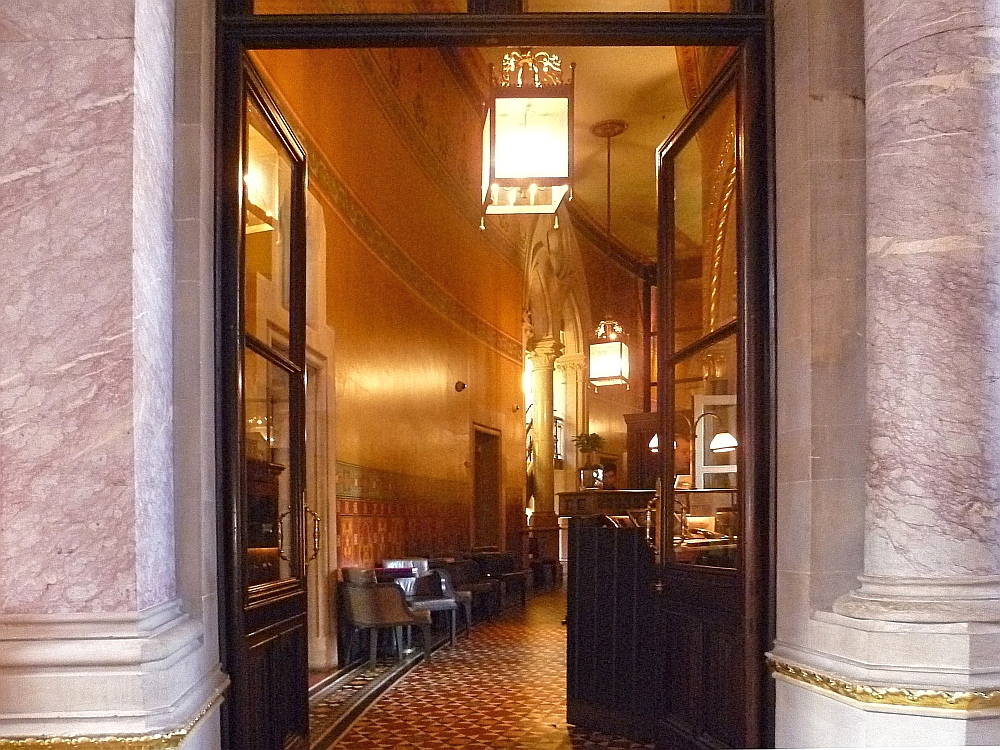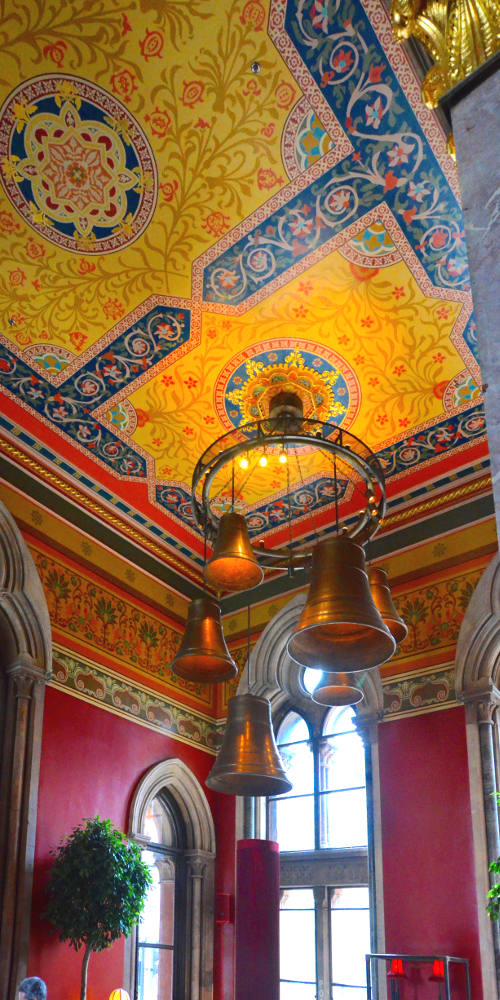Photographs, image capture, and formatting by the author. [You may use these images without prior permission for any scholarly or educational purpose as long as you (1) credit the photographer or image source, and (2) link your document to this URL in a web document or cite the Victorian Web in a print one. Click on the images for larger pictures.]
Introduction

This early engraving of the Midland Grand Hotel usefully shows, on the extreme left, the arcaded porte cochère in front of the former main entrance. Note that it also shows something that was never there at all — the extra storey that Scott had proposed, but that was never built. The picture was still used in publicity material about the hotel, as in the present source (Williams 666).
Sir George Gilbert Scott's Midland Grand Hotel at St Pancras, on the Euston Road in north-west London, is one of the most prominent and best-loved monuments to the Gothic Revival in the capital. Aptly described as "the gorgeous fruit of his great disappointment" (Clark 172), it expresses the vision that the architect had fought unsuccessfully to embody at the Foreign Office in Whitehall. Having been forced to give way and deliver a neo-classical complex at that stage of the Battle of the Styles, he designed the Midland Grand in his preferred mode instead. When writing his memoirs, he still seems bitter about the earlier defeat, grumbling that the St Pancras building was "possibly too good for its purpose" (271). But it has turned out to be great landmark all the same.
The purpose-built hotel was already a familiar part of the railway network when Scott first drew up his plans. The earliest hotel built specifically to serve a station had been constructed just up the road at Euston Station, opening "by stages, beginning in September 1839" (Simmons 37). The next ones to open in London were at King's Cross and Paddington in 1854. The latter, the Great Western Hotel designed by P. C. Hardwick, was the real milestone: it dominated the station itself, and was truly big and grand. Obviously, the commercial possibilities of such a hotel had now been recognised and were being fully exploited. Other large hotels followed. But the Midland Grand, built 1868-76, was something else again, "perhaps the most spectacular Victorian hotel of any kind, except the Grand at Scarborough" (Simmons 39). Proudly announcing the arrival of the Midland Company in the capital, both station and hotel were to be really special. Unlike the other hotels mentioned, but like those already constructed at Charing Cross and Canon Street, this hotel was an integral part of the whole design, stretching along the station front and both screening and giving access to it.
There were occasional problems. The Bury and Norwich Post, and Suffolk Herald reported that one of the early guests died after falling over the banisters (13 October 1874, p.7); later, according to Barrow's Worcester Journal, a resident clerk was crushed to death when trying to operate the luggage lift after midnight (17 June 1876, p.6); and a couple of years later the manager was fined for having a furnace in the laundry "not constructed so as to consume its own smoke" (Daily News 31 July 1878, p. 4). But on the whole the Midland Grand, with its advanced as well as luxurious amenities, like "speaking tubes" and those potentially dangerous "ascending chambers" (i.e. lifts), flourished during the nineteenth century (see Lansley 163).
However, the huge palatial structure was getting too costly to maintain. Besides, by the early twentieth century, its High Victorian opulence had gone out of fashion. Arthur Mee, the historian and editor of the King's England series, a dependable barometer of taste in this period, echoes the view of it as "Scott's tawdry masterpiece" (558). It was closed in 1935, and became increasingly the particular butt of critics "for its size and pretension, its colour and ornamentation," not to mention its apparently "rather improper association of cathedral architecture with railway lines" (Sir John Summerson, qtd. in Stamp 25). A few decades later it was still in use as railway company offices under the name of St Pancras Chambers — but fast deteriorating inside.
Yet, as demolition loomed, the beleaguered Midland Grand became a cause célèbre. Today it has further significance in the history of architecture. In its splendid reincarnation, it represents the greatest triumph of a whole spate of campaigns to preserve Britain's Victorian heritage. Its future was secured by its upgrading from a Grade III to a Grade I listing in 1967, and the London & Continental Railways at length took steps towards finding developers for its costly and painstaking restoration. Completed in 2011, the renamed St Pancras Renaissance Hotel gives us a good idea of the Midland Grand's original impact.
Former Entrance Hall (now the Gilbert Scott Bar)


The stunning decor that greets the guest coming in off the Euston Road. Left: The restored carved and gilded decoration on the inner entrance to the hotel, with peacocks, vases and foliage, the carving executed by Farmer & Brindley (see Bradley 107). Right: Arcade to the left, with its elaborate Venetian Gothic arches.
Apparently to broaden its clientele, and show that it was intended not just to serve travellers (see Bradley 106), the Midland Grand's main entrance was located right at the western corner with Midland Road, on the side now nearest to the much newer British Library. Though not central, this entrance was by no means insignificant, marked as it was by an elaborate, arcaded porte-cochère (see the far left of the first picture above). Before the Victorian period was out, this had another striking feature: the second earliest revolving door in the country, supplied by an American company called Van Kannel (Bradley 107). This has been reproduced for the entry to the restored hall, which now serves as the Gilbert Scott Bar. Despite its rather radical change of function, the rectangular space within still encapsulates the mix of extravagance and practicality that distinguished the whole complex.


Left to right: (a) Seen through one of the twin arched doors, the main passage winds away rather like a railway track, into the inner part of the hotel. Note the geometric encaustic Minton tiling of "hallucinating complexity" (Lansley 163). (b) The hallway seen from the opposite end.


Left to right — two views of the encaustic floor tiles: (a) Tiles in the vestibule near the doorway to the street parallel to the Grand Hotel. (b) Tiles in the hallway above.
Replete with rich, detailed, gilded carving and equally detailed and even more colourful painted decoration, the entrance hall was intended to dazzle, and it does. The main architectural features are the arched double doorway through to the main hotel, and the arcade on its left. As for the former, the effect is increased by the disappearing passage beyond. Since the porte-cochère stands at the beginning of the curved approach to the car and carriage entrance to the station, the passage naturally follows that line. The open arcade to the left also directs the vision from the entrance to the inner spaces of the hotel, into what was originally the porter's office. But the eye is bound to rest for a while on the exotic-looking Gothic arches topped by large Gothic quatrefoils, setting the scene for such elements throughout.


Left to right: (a) Intricate and brilliantly coloured stencilled patterning on the ceiling. (b) The frieze around the walls.
The dramatic architectural elements are complemented by the vivid interior painting and stencilling. The earliest painted decoration in the hotel was to Scott's designs, carried out by Frederick Sang (active, according to Christie's details, from 1840-84). Sang's earlier work with his partner Naundorff can be seen at the Old Conservative Club in St James's Street. That Sang was Scott's choice, suggests that the architect, who had never designed a hotel before, had that kind of gentleman's club ambience in mind. This was until escalating costs drove the Midland Railway to give the interior work to the firm of Gillow & Co. (later, Waring and Gillow). The entrance hall was decorated by Gillow (Bradley 107), but very early on: the listing text says that, like the saloon above, it retained "the painted decoration from the first half of the 1870." No doubt there was some degree of carry-over from the Scott/Sang collaboration. Certainly, the ceiling is striking in both colour scheme and pattern. The former can rightly been described as "dazzling" (Thorne 158.n), and the latter reflects the Moorish aspect of the Gothic in the architectural carving.


The great bells of the current light fitments are made of fibreglass, but their ecclesiastical look emphasizes the Gothic elements here.
One of the entrance hall's original light fitments can be seen in an 1876 picture (see Lansley 163, top). It is exactly like those used now in the hotel corridors, e.g. the one shown in the main curving passage, in the single right-hand photograph above. According to the listing text, electric lighting was installed in the hotel 1885-80. This was the occasion of the first major redecoration of the rooms, but some key interiors, such as the entrance hall, remained as they were. It is unlikely that anything like these sets of great fibreglass bells appeared here at that point, but they do "chime" with the other Gothic features. So, even in this carefully restored part of the old hotel, there is now a mix of the old and the pseudo-old, and sometimes the unmistakably modern — in this case, the bar fitments. Inevitably, the clock has been turned back only when practicable, and then not always to the earliest period, and some new touches have been added.
Scott may not have minded this. His own plans merged past and present in what one commentator calls a "mature and intelligent fusion" (Bradley 172). And the entrance hall, despite its new role, still functions just as he intended, welcoming visitors from the frantic urban thoroughfare outside, and striking them with surprise and delight in equal measure.

Related Material
- Exterior of Hotel, with Victorian and later commentaries (the former main entrance is just off the extreme left of this picture)
- Architectural sculpture on the porte-cochère (top two pictures)
- Ground Floor Arches: A Gallery
- The Grand Staircase
- The Hotel Atrium
Sources
19c British Library Newspapers (Gale; via library portal). Web. 26 October 2012.
Bradley, Simon. St Pancras Station. Rev. and updated ed. London: Profile, 2011. Print.
Clark, Kenneth. The Gothic Revival: An Essay in the History of Taste. London: Penguin (Pelican), 1964. Print.
"Frederick J. Sang (fl. 1840-1884)." Christie's. Web. 26 October 2012.
Lansley, Alastair, et al.. The Transformation of St Pancras Station. London: Lawrence King, 2008. Print.
Mee, Arthur. London: Heart of Empire and Wonder of the World. The King's England Series. London: Hodder and Stoughton, 1937. Print.
"St Pancras Station and Former Midland Grand Hotel, Camden." British Listed Buildings. Web. 26 October 2012.
Scott, Sir George Gilbert, R.A. Personal and Professional Recollections, edited by his son, G. Gilbert Scott, F.S.A.. London: Sampson Low, Marston, Searle, & Rivington, 1879. Internet Archive. Web. 26 October 2012.
Simmons, Jack. The Victorian Railway. Corrected paperback ed. London: Thames & Hudson, 1995. Print.
Stamp, Gavin. Lost Victorian Britain: How the Twentieth Century Destroyed the Nineteenth Century's Architectural Masterpieces. London: Aurum Press, 2010. Print.
Thorne, Robert. In St. Pancras Station, by Jack Simmons, revised by Robert Thorne. Republished 2d ed. London: Historical Publications, 2003. Print.
Williams, Frederick Smeeton. The Midland Railway: Its Rise and Progress; A Narrative of Modern Enterprise. London: Strahan, 1876. Internet Archive. Web. 26 October 2012.